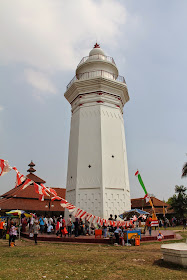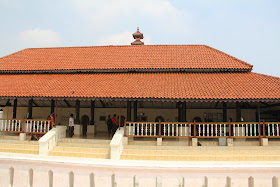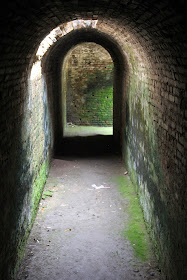From Bandung I ventured to the Indonesia province of Banten in the western end of Java. I rode the bus from Bandung to the town of Cilegon and then from there my primary mode of transportation was the ubiquitous angkot (short for angkutan kota meaning city transport) (seen in green above). These minvans have one side entrance with two parallel benches in the back.

Here are some of the passengers on my morning ride from my hotel to the marina for my ride to Krakatau.
Most of these passengers got off at their elementary school only to then have more passengers climb aboard.
These were the passengers on the way back from Krakatau. There were 14 passengers crammed in the tiny van at one point.
Sunset over the Sunda Strait from my hotel.
The next morning I hired my own private angkot so I could stop at some sites along the way. Rural coastal west Java.
The metal lighthouse in Anyer built by the Dutch in 1885, just two years after Krakatau decimated the whole town of Anyer.
They were have some sort of ceremony on the grounds of the lighthouse so it was technically closed, but I convinced the caretaker to let me in because I was a university professor who wanted to take some photos to show my students. It was a hot muggy climb up the many steps.
Looking south.
West to the small harbor.
North towards a growing industrial zone.
East to the mountains. The 40 meter high tsunami generated by the collapse of Krakatoa wiped out this whole coastal plain.
Two tankers on the Sunda Strait to the northeast of where Krakatau is located (and visible on clear days).
When I went to leave the door didn't seem like it wanted to open so I thought the caretaker had locked me in (I thought perhaps to keep other visitors out). I banged on the door until some boys were able to push the door open from the outside.
Guests at the ceremony just outside the lighthouse.
Bamboo homes would not be very capable of standing up to a tsunami.
There are now dozens of factories in the Anyer/Cilegon area. Cement (above), plastics, chemicals.
The Krakatoa Industrial Zone and its tenants.

The main mosque of Cilegon.
The minaret of the 16th century Great Mosque of Banten. Coastal Banten was the capital of a powerful maritime sultanate that strongly resisted the coming of the Dutch.
Mosque and minaret.
Banten is now a sleepy town with little evidence of its onetime economic and political power.
The roof of the mosque.
Market stalls form a labyrinth around the entry to the mosque.
Looking north to the Java Sea.
Hats for sale.
They asked to take their photo with me. I keep thinking that one day Facebook face recognition abilities will tag me in one of the many photos of me and my new Indonesian friends taken during my journeys.
Adjacent to the mosque is the cemetery and a burial shrine of a Muslim notable.
To the northwest of town is a newly built (atop a centuries old temple destroyed by fire) Chinese Temple.
This account of the eruption of Krakatau describes how "water and lava didn't come into the temple."



The coming of Chinese merchants and immigrants to Banten.
Fire destroys the temple (klenteng).
Pilgrims some to the new temple from Jakarta, Malaysia and elsewhere.
Across from the temple are the remains of the Dutch Fort Spellwijk built in 1682.
The Java Sea in the distance.
The basement prison.
From Banten I then caught a bus back to Jakarta and lo and behold there were more serenaders, this time a trio of violin, guitar and vocalist/money collector.
Saturday night I joined the Jakarta 2nd ward for their Independence Day talent show. It was very well done--entertaining and full of talent.
Next morning as I left my hotel to catch a taxi to church I happened upon the once a month Sunday morning closure of Jalan Thamrin so that pedestrians, joggers and bicyclists can enjoy the main road of Jakarta without its congested traffic.
Nice detail on the fence posts at the Jalan Dr. Saharjo chapel.
Always great to visit with so many good friends.































































